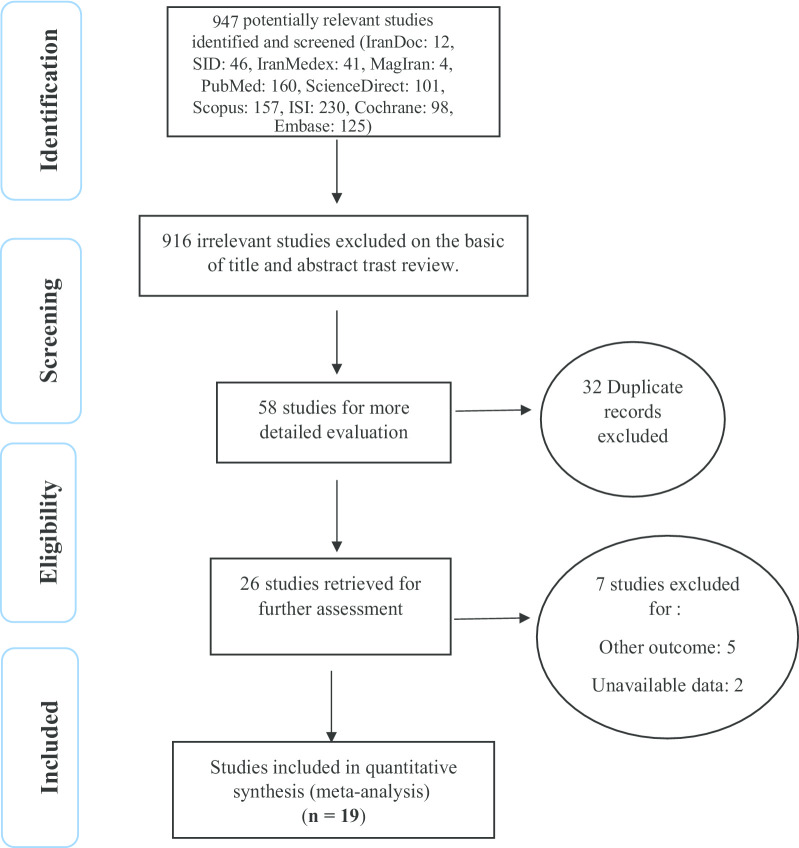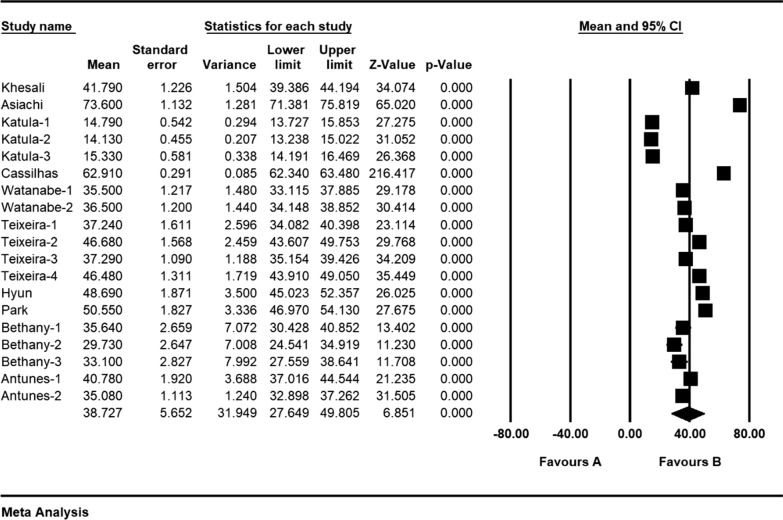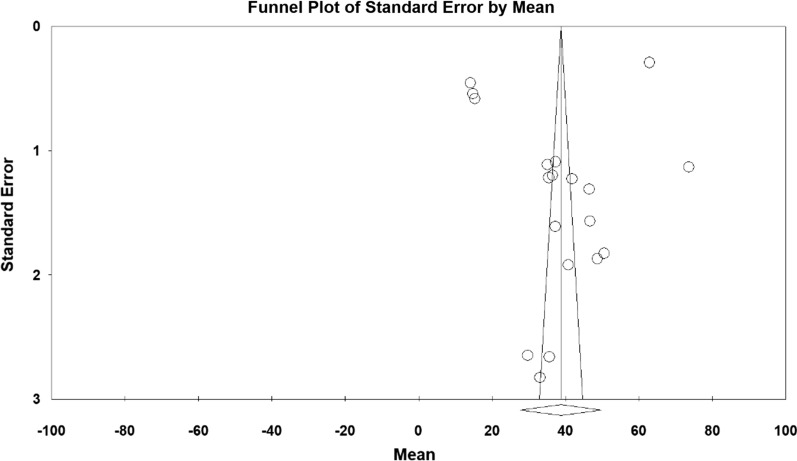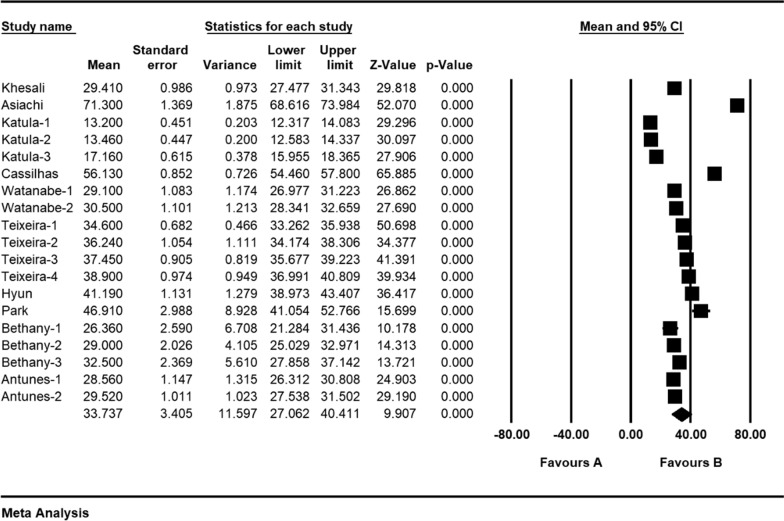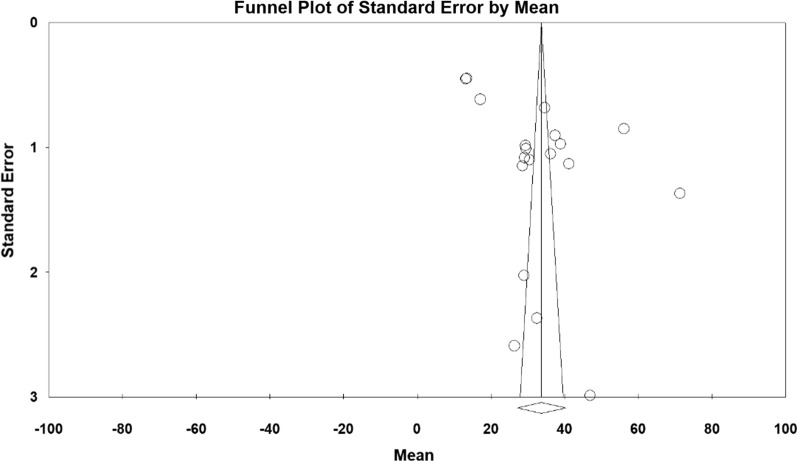Abstract
Background
Physical activity and exercise are among the most important, simplest, and cheapest approaches to anxiety treatment, especially for the elderly. Their positive effects on improvement of mental disorders in the elderly have attracted a considerable level of attention. Therefore, the present study was conducted to determine the effect of sport on reducing anxiety in the elderly using meta-analysis.
Methods
In this study, national and international databases of SID, MagIran, IranMedex, IranDoc, Cochrane, Embase, ScienceDirect, Scopus, PubMed, and Web of Science were searched to find studies published electronically from 1999 to 2019. Heterogeneity between the collected studies was determined using the Cochran's test (Q) and I2. Due to presence of heterogeneity, the random effects model was used to estimate the standardized mean difference of sport test scores obtained from the measurement of anxiety reduction among the elderly, between the intervention group before and after the test.
Results
In this meta-analysis and systematic review, 19 papers finally met the inclusion criteria. The overall sample size of all collected studies for the meta-analysis was 841 s. Mean anxiety score before and after intervention were 38.7 ± 5.6 33.7 ± 3.4 respectively, denoting a decrease in anxiety score after intervention.
Conclusion
Results of this study indicates that Sport significantly reduces Anxiety in the Elderly. Therefore, a regular exercise program can be considered as a part of the elderly care program.
Keywords: Sport, Anxiety, Elderly, Meta-analysis
Background
Aging is an inevitable process in all human beings [1]. It is a natural developmental stage in which particular physical, psychological, and social changes occur [2]. In other words, aging is referred to spontaneous and progressive irreversible analytical changes in which both physical and mental forces are significantly impaired [3].
According to the World Health Organization (WHO), it is estimated that, by 2020, the population of people over 65 years of age will account for 20% of the world's population, while about 70% of them live in developing countries [4]. In the elderly, all organs of the body undergo a degree of deterioration in their functions; consequently, many chronic diseases occur in the elderly including cardiovascular diseases (e.g. hypertension, coronary artery disease), skeletal diseases (e.g. arthritis, osteoporosis), and mental disorders (such as anxiety and depression) [4–6].
Although anxiety occurs in all age groups, it is a common disorder in the aging period and is more debilitating in the elderly [6, 7]. The elderly are more prone to stress and anxiety as a result of loss or reduction of self-esteem, reduction of activity and stimulation, loss of friends and relatives, loss of physical independence and chronic diseases, changes in daily life or living environment, fear of death and lack of social support [6, 7]. Over 40 million adults in the US suffer from anxiety disorders [6].
Prevalence of anxiety symptoms in the elderly is 15–52% and anxiety disorders occur in 3–15% of adults and are common in the elderly with chronic diseases in particular [8]. Anxiety mostly manifests as physical symptoms such as insomnia, behavioral, sensory, urinary, cardiovascular, and gastrointestinal disorders in the elderly [9, 10].
Important and negative consequences of anxiety include decreased quality of life, disability and greater need for health services, and increased mortality, and therefore, early identification and appropriate treatment would prevent these consequences [7–12].
Physical activity and sport is among the most important, simplest, cheapest, and available therapeutic approaches, especially for the elderly [13]. Sport makes different parts of muscles to interact with each other. In each joint, there is a desired range of motions that are essential for maximum performance. Flexibility is important, not only for physical activity, but also to prevent injury. Inactivity causes the joints to lose their flexibility, as connective tissues become shorter [14]. Atashzadeh et al. [15] argued that exercise training improves daily activities.
There are several preliminary studies on the effect of exercise training on reducing anxiety in the elderly, and there are inconsistencies between their results. One of applications of meta-analysis studies is to respond to these assumptions and resolve such inconsistencies; therefore, the present study was conducted to determine the effect of sport on alleviating the elderly’s anxiety using meta-analysis.
Methods
Method used for searching the papers
In this study, the Persian databases of SID, MagIran, IranMedex, and IranDoc and the international databases of Cochrane, Embase, ScienceDirect, Scopus, PubMed, and Web of Science were searched aimed at finding relevant sources from 1999 until December 2019. The lists of references used in all related papers and reports found in above electronic searches were manually reviewed to find other possible sources. The keywords used to search for resources were selected from the Medical Subject Headings (MeSH) database. The Persian keywords were Sport, Anxiety, and The Elderly and the Latin keywords were Exercise, Aerobic Exercise, Exercise Training, Physical Activity, Anxiety, Elderly, and Old.
Inclusion criteria for selection of the papers
Papers with the following characteristics were selected for the meta-analysis: (1) original research papers, (2) clinical trial studies, (3) full-text availability, and (4) the studies that investigated the relationship between sport and anxiety in the elderly.
Exclusion criteria for the papers
Selected studies were evaluated more accurately. Review studies or those which their sample had not been selected among the elderly, as well as duplicate studies, and studies conducted using previous data, were excluded from the meta-analysis. Finally, 26 studies entered the third stage, namely quality evaluation.
Qualitative evaluation of the studies
Quality of the papers were evaluated based on the selected and relevant items present in the CONSORT checklist; the selected items were study design, background and literature review, place and time of study, outcome, inclusion criteria, sample size, and statistical analysis. Articles fulfilling 6 or 7 criteria are considered as high-quality articles; studies having 2 or above, and articles with less than 2 criteria are considered as medium and low-quality articles respectively [16]. In the present study, 19 papers were included in the systematic review and meta-analysis as they were assessed as medium or high-quality articles, and 7 papers were of low quality and were therefore excluded.
Extracting the data
All final papers entered into the meta-analysis process were prepared for extraction of their data, by a different checklist. The checklist included the following fields: title of the paper, first author's name, year of publication, place of study, sample size of intervention group, mean sample before and after intervention, standard deviation of sample before and after intervention, and type of intervention.
Statistical-analysis
Given that the context under study was the effect of sport on the elderly anxiety, frequency and percentage were used to combine the results of various research works. The standardized mean difference index was also used in each study. The I2 index was used to investigate homogeneity between studies, and due to heterogeneity in the selected research works, the random effects model was used to amalgamate the reported results and to perform the meta-analysis. When the I2 index was less than 25%, heterogeneity was considered as low, the value between 25 and 75% was considered as moderate heterogeneity, and the value more than 75% was regarded as high heterogeneity. P-value less than 0.05 was considered as statistically significant. The funnel diagram and Egger’s test were also conducted to evaluate publication bias.
Results
In this work, all studies focusing on the effect of sport on the elderly anxiety were systematically reviewed according to the Preferred Reporting Items for Systematic Reviews and Meta-Analyses (PRISMA) guidelines. A total of 974 papers were identified in the initial search, and finally, 19 studies published from 1999 until December 2019 were included in the final evaluation (Fig. 1).
Fig. 1.
Flow diagram of study selection
The total number of participants was 841 in the intervention group. Table 1 shows the characteristics of the studies included in systematic review along with the type of administered sport (Table 1).
Table 1.
Specifications of studies entered into the meta-analysis
| Author, year, reference | Place of Type of exercise study | Type of exercise | Sample size | Mean ± SD of before | Mean ± SD of after | Quality |
|---|---|---|---|---|---|---|
| Khesali, 2018, [17] | Iran | Tai Chi Chuan | 60 | 41.79 ± 9.5 | 29.41 ± 7.64 | High |
| Asiachi, 2017, [18] | Iran | Yoga | 30 | 73.6 ± 6.2 | 71.3 ± 7.5 | Medium |
| Katula-1, 1999, [19] | USA | Exercise Light | 80 | 14.79 ± 4.85 | 13.2 ± 4.03 | High |
| Katula-2, 1999, [19] | USA | Exercise Moderate | 80 | 14.13 ± 4.07 | 13.46 ± 4.0 | High |
| Katula-3, 1999, [19] | USA | Exercise Maximal | 80 | 15.33 ± 5.2 | 17.16 ± 5.5 | High |
| Cassilhas, 2010, [20] | Brazil | 24 weeks of resistance exercise | 20 | 62.91 ± 1.3 | 56.13 ± 3.81 | High |
| Watanabe-1, 2000, [21] | Japan | Water-based Exercise | 36 | 35.5 ± 7.3 | 29.1 ± 6.5 | Medium |
| Watanabe-2, 2000, [21] | Japan | Land-based Exercise | 37 | 36.5 ± 7.3 | 30.5 ± 6.70 | Medium |
| Teixeira-1, 2013, [22] | Portugal | Physical Activity Scale (23) | 70 | 37.24 ± 13.48 | 34.6 ± 5.71 | High |
| Teixeira-2, 2013, [22] | Portugal | Physical Activity Scale (23) | 70 | 46.68 ± 13.12 | 36.24 ± 8.82 | High |
| Teixeira-3, 2013, [22] | Portugal | Physical Activity Scale (23) | 70 | 37.29 ± 9.12 | 37.45 ± 7.57 | High |
| Teixeira-4, 2013, [22] | Portugal | Physical Activity Scale (23) | 70 | 46.48 ± 10.97 | 38.9 ± 8.15 | High |
| Hyun, 2009, [24] | Korea | Danjeon Breathing Exercise | 37 | 48.69 ± 11.38 | 41.19 ± 6.88 | High |
| Park, 2011, [25] | Korea | Tai Chi Exercise | 23 | 50.55 ± 8.76 | 46.91 ± 14.33 | High |
| Bethany-1, 2005, [26] | USA | Yoga | 11 | 35.64 ± 8.82 | 26.36 ± 8.59 | High |
| Bethany-2, 2005, [26] | USA | Aerobics | 11 | 29.73 ± 8.78 | 29.0 ± 6.72 | High |
| Bethany-3, 2005, [26] | USA | Walking | 10 | 33.1 ± 8.94 | 32.5 ± 7.49 | High |
| Antunes-1, 2005, [27] | Brazil | Endurance exercise | 23 | 40.78 ± 9.21 | 28.56 ± 5.5 | Medium |
| Antunes-2, 2005, [27] | Brazil | Endurance exercise | 23 | 35.08 ± 5.34 | 29.52 ± 4.85 | Medium |
According to the available data, indices such as the standardized mean difference and relative risk in the studies were used to determine the final significance of the studies. For research works, in which standard deviation of mean (SD) had been reported, the standardized mean difference index was used in the meta-analysis. Results obtained from the meta-analysis showed heterogeneity between the collected studies, heterogeneity results were reported before intervention (I2 = 99.8) and after the intervention (I2 = 99.6), thus, the random effects model was used to amalgamate the reported results of the studies and to provide an overall approximation.
Based on the results obtained from the meta-analysis, the standardized mean difference between the intervention groups was estimated to be 38.7 ± 5.6 and 33.7 ± 3.4 before and after the intervention respectively, indicating that sport reduces anxiety in the elderly. Accumulation graph (Figs. 2 and 3) pesents the standardized mean difference index, as well as the final estimate of the index obtained from combination of all reported results. In this graph, the width of each square also denotes the 95% confidence interval. The Egger's test was used to investigate presence of publication bias in the articles. According to the Egger's test results, there was no pre-intervention (P = 0.549) and post-intervention (P = 0.058) publication bias in the studies (Figs. 4 and 5).
Fig. 2.
Accumulation diagram of studies included in meta-analysis using standardized mean difference index before intervention
Fig. 3.
Funnel plot plotted according to the studies included in meta-analysis using standardized mean difference index before intervention
Fig. 4.
Accumulation diagram of studies included in meta-analysis using standardized mean difference index after intervention
Fig. 5.
Funnel plot plotted according to the studies included in meta-analysis using standardized mean difference index after intervention
Discussion
The present study was carried out to determine the effect of sport on reducing anxiety in the elderly using a meta-analysis. Anxiety stems from the inability to solve psychological conflicts, and generally, a large part of the human psychic forces are spent on solving psychological conflicts. For this reason, people with psychological disorders cannot make the best use of their abilities and talents; since mental conflicts deplete their psychic energy and power and cause dissonance in investing for all their psychological dimensions and needs [28].
Results of this study showed that the level of anxiety was high before the test, indicating the effects of anxiety and its consequences on all aspects of life of the elderly.
Therefore, interventions should be made to change the lifestyle and regularly control anxiety of individuals in order to prevent the disorder and reduce its associated complications [28]. Anxiety is primarily preventable and can be controlled and treated in the complication, the elderly need to be thoroughly trained about anxiety and preventing its complications. Besides, the disorder can be controlled and treated through early diagnosis before its complications emerge.
Given the high prevalence of anxiety in the elderly, it is suggested that physicians pay more attention to the symptoms of the disorder and provide appropriate education and training to raise awareness of the individuals, with a view to reduce diagnosis delay.
Results from the present study shows a significant difference in mean scores of pre-test and post-test regarding anxiety severity in the elderly in the intervention group.
Primary benefits of regular exercise, such as increased cardio respiratory fitness, increased muscle strength and endurance, reduced body fatigue, improved morale, and increased ability to perform daily tasks, were found to be greater in the elderly. Moreover, exercise significantly influences and helps to control anxiety and improve general health [29].
Several studies have confirmed positive effects of sport among children, teenagers, adolescents, and adults [17, 18]. Various studies around the world have shown that, sport reduces intensity of anxiety and its recurrence after quitting the sport. Berger and Owen demonstrated that physical exercise has a significant effect on reducing anxiety [31]. DiLorenzo et al. investigated long-term effects of aerobic exercise on anxiety, depression, and emotional states. Their research work showed a relationship between improving participants' physical fitness in aerobic exercises and reducing their anxiety, and anti-anxiety effects of sport continued during a 12-week follow-up after exercise [32].
Anti-Anxiety effects of sport can be explained by a variety of mechanisms, including biological, physiological, and psychological mechanisms of sport. Biologically, sport can have anti-anxiety effects by providing individuals with access to physical fitness; influencing the level of neurotransmitters involved in anxiety, reducing stress hormones, and decreasing muscle tension following exercise activities [33]. Psychologically, sport can reduce anxiety by increasing activity levels, followed by increasing positive conditional reinforcements to the response, providing a situation that distracts individual's attention from threatening stimuli and anxiety, and providing an environment for elevating self-esteem and self-empowerment [33–37]. Experts are advised to use regular sports as a complementary treatment along with medications to help the elderly.
Limitation
One of the limitations of the present study was completion of the sports survey form by the elderly at their homes as reported in the papers included in this meta-analysis; the survey responses may have been influenced by mental status or inadequate accuracy of the participants’ responses.
Conclusion
Results of this study showed that sport significantly reduces anxiety in the elderly. Therefore, a regular exercise plan can be considered as a part of the elderly care program.
Acknowledgements
The authors thank the faculty members of the Faculty of Nursing and Midwifery, Kermanshah University of Medical Sciences.
Abbreviations
- WHO
World Health Organization
- CONSORT
Consolidated Standards of Reporting Trials
- PRISMA
Preferred Reporting Items for Systematic Reviews and Meta-Analysis
Authors’ contributions
MK and NR contributed to the design, MM and RJ statistical analysis, participated in most of the study steps. AA and SHSH prepared the manuscript. NS and AVR and AD and MHF assisted in designing the study, and helped in the, interpretation of the study. All authors have read and approved the content of the manuscript.
Funding
By Student Research Committee of Kermanshah University of Medical Sciences, Deputy for Research and Technology, Kermanshah University of Medical Sciences (IR) (3009378).
Availability of data and materials
Datasets are available through the corresponding author upon reasonable request.
Ethics approval and consent to participate
Not applicable.
Consent for publication
Not applicable.
Competing interests
The authors declare that they have no conflict of interest.
Footnotes
Publisher's Note
Springer Nature remains neutral with regard to jurisdictional claims in published maps and institutional affiliations.
Contributor Information
Mohsen Kazeminia, Email: mohsenkaz221@gmail.com.
Nader Salari, Email: n_s_514@yahoo.com.
Aliakbar Vaisi-Raygani, Email: visi_akbar@yahoo.com.
Rostam Jalali, Email: ks_jalali@yahoo.com.
Alireza Abdi, Email: a_abdi61@yahoo.com.
Masoud Mohammadi, Email: Masoud.mohammadi1989@yahoo.com.
Alireza Daneshkhah, Email: ac5916@coventry.ac.uk.
Melika Hosseinian-Far, Email: mel.hosseinian@gmail.com.
Shamarina Shohaimi, Email: shamarina@upm.edu.my.
References
- 1.Firozeh Moghadam S, Borjali A, Sohrabi F. The efficiency of happiness training to increase the hope in elderly people. Iran J Ageing. 2014;8(4):67–72. [Google Scholar]
- 2.Allender J, Rector C, Rector C, Warner K. Community & public health nursing: Promoting the public's health. Philadelphia: Lippincott Williams & Wilkins; 2013. [Google Scholar]
- 3.Fiori KL, Smith J, Antonucci TC. Social network types among older adults: a multidimensional approach. J Gerontol B Psychol Sci Soc Sci. 2007;62(6):P322–P330. doi: 10.1093/geronb/62.6.p322. [DOI] [PubMed] [Google Scholar]
- 4.Salehi L, Salaki S, Alizadeh L. Health-related quality of life among elderly member of elderly centers in Tehran. Iran J Epidemiol. 2012;8(1):14–20. [Google Scholar]
- 5.Hamidizadeh S, Ahmadi F, Fallahi M. The effect of progressive muscle relaxation on blood pressure in elderly patients with primary hypertension in elderly people living in the center of the Kahrizak in 2004. J Rehabil. 2004;5(4):48–52. [Google Scholar]
- 6.Alipour F, Sajadi H, Forouzan A, Nabavi H, Khedmati E. The role of social support in the anxiety and depression of elderly. Iran J Ageing 2009;4(1)
- 7.Boyd MA. Psychiatric nursing: contemporary practice, lippincott. Philadelphia: Williams & Wilkins; 2008. [Google Scholar]
- 8.Ryan J, Scali J, Carrière I, Scarabin P-Y, Ritchie K, Ancelin M-L. Estrogen receptor gene variants are associated with anxiety disorders in older women. Psychoneuroendocrinology. 2011;36(10):1582–1586. doi: 10.1016/j.psyneuen.2011.04.011. [DOI] [PubMed] [Google Scholar]
- 9.Bergua V, Meillon C, Potvin O, Bouisson J, Le Goff M, Rouaud O, Ritchie K, Dartigues J-F, Amieva H. The STAI-Y trait scale: psychometric properties and normative data from a large population-based study of elderly people. Int Psychogeriatr. 2012;24(7):1163–1171. doi: 10.1017/S1041610212000300. [DOI] [PubMed] [Google Scholar]
- 10.Atashi V, Mohammadi F, Dalvandi A, Abdollahi I, Shafiei Z. Effect of slow stroke back massage on anxiety in patients with stroke A-randomized clinical trail. Journal of clinical nursing Mdwifery. 2013;2(4):45–52. [Google Scholar]
- 11.Smalbrugge M, Pot A, Jongenelis K, Beekman A, Eefsting J. Prevalence and correlates of anxiety among nursing home patients. J Affect Disord. 2005;88(2):145–153. doi: 10.1016/j.jad.2005.06.006. [DOI] [PubMed] [Google Scholar]
- 12.Lavretsky H, Alstein LL, Olmstead RE, Ercoli LM, Riparetti-Brown M, Cyr NS, Irwin MR. Complementary use of tai chi chih augments escitalopram treatment of geriatric depression: a randomized controlled trial. Am J Geriatr Psychiatry. 2011;19(10):839–850. doi: 10.1097/JGP.0b013e31820ee9ef. [DOI] [PMC free article] [PubMed] [Google Scholar]
- 13.Aslankhani MA, Farokhi A, Shamsipour Dehkordi P, Shams A, Ghasemian Moghaddam MR. The relation of personality traits Wth depression severity in active and non-active elderly women in Tehran City. Iran J Ageing. 2010;5(2)
- 14.Walker B. The benefits of stretching improved range of movement increased power reduced post exercise muscle soreness reduced fatigue. Walkerbout Health Pty Ltd; 2007. p. 12.
- 15.Atashzade F, Shiri H, Moshtagh Z, Sanii M. Effect of regular aerobic exercise on improving activity daily living. Rafsanjan Med J. 2003;2(3–4):164–171. [Google Scholar]
- 16.Eldridge SM, Chan CL, Campbell MJ, Bond CHM, Hopewell S, et al. CONSORT 2010 statement: extension to randomized pilot and feasibility trials. BMJ. 2016;355:i5239. doi: 10.1136/bmj.i5239. [DOI] [PMC free article] [PubMed] [Google Scholar]
- 17.Khesali Z, Mohammadi Shahboulaghi F, Khankeh H, Biglarian A. Eeffect of “Tai Chi Chuan” on Anxiety among elderly women. Sci J Nurs Midwifery Paramed Fac. 2018;3(4):15–23. [Google Scholar]
- 18.Asiachi N, Sanatkaran A, Bahari SM. The effect of yoga on anxiety in elderly men and women. In: First national conference on sport and health sciences achievements. Abadan University of Medical Sciences; 2017. p 1–11 (in Persian)
- 19.Katula JA, Blissmer BJ, McAuley E. Exercise intensity and self-efficacy effects on anxiety reduction in healthy, older adults. J Behav Med. 1999;22(3):233–247. doi: 10.1023/a:1018768423349. [DOI] [PubMed] [Google Scholar]
- 20.Cassilhas RC, Antunes HKM, Tufik S, De Mello MT. Mood, anxiety, and serum IGF-1 in elderly men given 24 weeks of high resistance exercise. Percept Mot Skills. 2010;110(1):265–276. doi: 10.2466/PMS.110.1.265-276. [DOI] [PubMed] [Google Scholar]
- 21.Watanabe E, Okada A, Takeshima N, Inomata K. Comparison of water-and land-based exercise in the reduction of state anxiety among older adults. Percept Mot Skills. 2000;91(1):97–104. doi: 10.2466/pms.2000.91.1.97. [DOI] [PubMed] [Google Scholar]
- 22.Teixeira CM, Vasconcelos-Raposo J, Fernandes HM, Brustad RJ. Physical activity, depression and anxiety among the elderly. Soc Indic Res. 2013;113(1):307–318. [Google Scholar]
- 23.Prochaska JJ, Sallis JF, Long B. A physical activity screening measure for use with adolescents in primary care. Arch Pediatr Adolesc Med. 2001;155(5):554–559. doi: 10.1001/archpedi.155.5.554. [DOI] [PubMed] [Google Scholar]
- 24.Hyun K-S, Won J-S, Kim W-O, Han S-S, Lee J-A. The effects of danjeon breathing exercise on vital capacity, physical fitness, anxiety and depression among older adults. J Korean Acad Commun Health Nurs. 2009;20(4):474–482. [Google Scholar]
- 25.Park Y-J, Kim M-S. Effect of Tai Chi exercise program on anxiety, powerlessness, and self-esteem in elderly women. J Mus Joint Health. 2011;18(2):147–157. [Google Scholar]
- 26.Bethany KH. The effects of selected exercise modalities on stress, anxiety, and depression responses in the elderly. Tallahassee: The Florida State University; 2005. [Google Scholar]
- 27.Antunes HKM, Stella SG, Santos RF, Bueno OFAMTD, Mello Depression, anxiety and quality of life scores in seniors after an endurance exercise program. Braz J Psychiatry. 2005;27(4):266–271. doi: 10.1590/s1516-44462005000400003. [DOI] [PubMed] [Google Scholar]
- 28.Akbari B. Relationship between commitment to prayer and anxiety, according to sociodemographic variables among students of Islamic Azad University Anzali. J Psychol Religion. 2009;2(3):145–155. [Google Scholar]
- 29.Hoseini SH, Rajabi H. The effects of 8 weeks home—based yoga and resistance training on the power of leg extensors, motor capacity and balance in patient with multiple sclerosis. M A Thesis of Physical Education an Science Faculty of KHarazmi University; 2012 (in Persian)
- 30.Izard CE. The face of emotion. New York: Appleton; 1971. p. P29. [Google Scholar]
- 31.Berger BG, Owen DR. Mood alteration with yoga and swimming: aerobic exercise may not be necessary. Percept Motor Skills. 1992;75(3_suppl):1331–1343. doi: 10.2466/pms.1992.75.3f.1331. [DOI] [PubMed] [Google Scholar]
- 32.DiLorenzo TM, Bargman EP, Stucky-Ropp R, Brassington GS, Frensch PA, LaFontaine T. Long-term effects of aerobic exercise on psychological outcomes. Prev Med. 1999;28(1):75–85. doi: 10.1006/pmed.1998.0385. [DOI] [PubMed] [Google Scholar]
- 33.Saeed SA, Cunningham K, Bloch RM. Depression and anxiety disorders: benefits of exercise, yoga, and meditation. Am Fam Physician. 2019;99(10):620–627. [PubMed] [Google Scholar]
- 34.Doyne EJ, Ossip-Klein DJ, Bowman ED, Osborn KM, McDougall-Wilson IB, Neimeyer RA. Running versus weight lifting in the treatment of depression. J Consult Clin Psychol. 1987;55(5):748. doi: 10.1037//0022-006x.55.5.748. [DOI] [PubMed] [Google Scholar]
- 35.Fabel K, Fabel K, Tam B, Kaufer D, Baiker A, Simmons N, Kuo CJ, Palmer TD. VEGF is necessary for exercise-induced adult hippocampal neurogenesis. Eur J Neurosci. 2003;18(10):2803–2812. doi: 10.1111/j.1460-9568.2003.03041.x. [DOI] [PubMed] [Google Scholar]
- 36.Becker RE, Heimberg RG, Bellack AS. Social skills training treatment for depression. Oxford: Pergamon Press; 1987. [Google Scholar]
- 37.Ossip-Klein DJ, Doyne EJ, Bowman ED, Osborn KM, Neimeyer RA. Effects of running or weight lifting on self-concept in clinically depressed women. J Consult Clin Psychol. 1989;57(1):158. doi: 10.1037//0022-006x.57.1.158. [DOI] [PubMed] [Google Scholar]
Associated Data
This section collects any data citations, data availability statements, or supplementary materials included in this article.
Data Availability Statement
Datasets are available through the corresponding author upon reasonable request.



